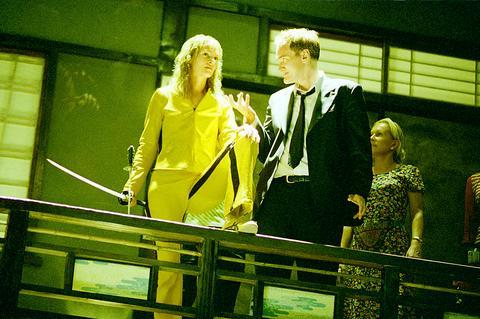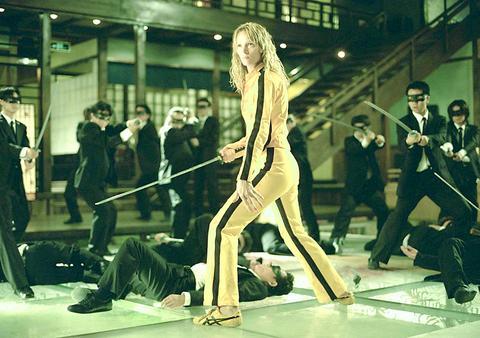Much has been made of the kung-fu grip of Quentin Tarantino's constantly morphing Kill Bill Vol. 1. But the commentary has missed one essential fact about Tarantino: he is the movie world's DJ and Kill Bill is another one of his mix tapes. He nestles his flamboyantly shallow film in a comforting bed of recycled music.
When Uma Thurman, as the back-from-the-living-dead Bride, hot on her mission of vengeance, goes knuckle to knuckle against one of her foes, Vivica A. Fox's Vernita, the sweaty, bloody dust-up is accompanied by one of the most outrageous needle-drop ripoffs in movie history: the shocking eruption of Quincy Jones's funked-up Theme From Ironside, from the Smackwater Jack album. (An indicator that action can commence, the music is repeated later in a climactic swordfight.)
DJ's watching Kill Bill will easily tick off the number of times the jazz/R n' B classic has been sampled by musicians, but old-school film fans know it best from Five Fingers of Death, one of the first non-Bruce Lee martial-arts pictures to hit it big in America. (Jones probably still strokes his throbbing temples when he recalls that Ironside was stolen, and used without permission in Five Fingers each time a fight scene began.) At least this time he's being paid. Movie buffs will also nod when they learn that Vernita's other name is Jeanne Bell. Here Tarantino wedges another layer into his thick sandwich of allusions: Jeanne Bell was the star of the blaxploitation throwdown TNT Jackson, and in one of the movie's best-known scenes, she took out a phalanx of thugs while topless.

PHOTO COURTESY OF PANDASIA
The stacking of multiple references is reminiscent of the 1998 song-compilation The Document, in which DJ Andy Smith connects the Jungle Brothers and Jeru the Damaja to the James Gang's suburban Funk No. 49 and Peggy Lee's version of Sittin' on the Dock of the Bay and, finally, to excerpts from a couple of the greatest blaxploitation soundtracks ever, Marvin Gaye's for Trouble Man and Barry White's for Brothers. Like a DJ so on top of his spins that he spreads the next jam just before you can think of it, Tarantino gives the Kill Bill audience a bit of crunch with Isaac Hayes's Truck Turner soundtrack and a bit of honey with Ennio Morricone's Death Rides a Horse, from the score for The Good, the Bad and the Ugly.
Music gives Tarantino a laser pointer that he uses to guide his audience through the film's stockpile of information. He begins a section of Kill Bill with Al Hirt's Flight of the Bumblebee. Hirt's trilling trumpet joins all of the Bruce Lee references together -- it's the theme from the film that introduced him to America, The Green Hornet. Lee played the Hornet's lethally floating sidekick Kato -- and stole the show from him. Just before Bumblebee vibrates soulfully from the soundtrack, a division of yakuza bodyguards turns up wearing Kato's uniform from Hornet -- black suit, white shirt, an E-string of a necktie and a black mask with raised corners. The sequence ends with the Bride in a yellow track suit with a black stripe -- an imitation of Lee's outfit in Game of Death. It's an epochal conflation and an explosion of visual flair from a filmmaker who thinks like a graphic artist and never got the chance to show it until this film.
Tarantino's not simply a film geek; he bridges several worlds of geekdom. There's a Japanese thrash girl band in the movie that could be something he picked up at Japan Music Night at the South by Southwest music festival in Austin, Texas. If you heard a DJ drop Nancy Sinatra's version of the Sonny and Cher corpse Bang-Bang and Santa Esmeralda's House of the Rising Sun -- which Tarantino does on the soundtrack here -- you'd run over and beg for the DJ's card. But unlike professional mixmasters, Tarantino is so eager to show off his collection of music and film information that he jumps to the next reference before you can start nodding your head in recognition.

Tarantino's movies pile up the visual references, high and low, with similar abandon: he's surely the first to use anime -- though not particularly well done anime -- and the French New Wave in the same film. Kill Bill, after all, flows from Francois Truffaut's Bride Wore Black, based on Cornell Woolrich's grim-reaper novel in which a young woman tracks down the men who ruined her life. In the Tarantino version, though, the Bride's enemies are often women. One of them, Elle Driver (Daryl Hannah), enters whistling a theme from Bernard Herrmann's Twisted Nerve score. She is lifted, complete with her Modesty Blaise trench coat, from a luridly engrossing piece of drive-in fodder from 1974, They Call Her One Eye. Elle sports the same eye patch and costume as that film's young female protagonist, who was mutilated and raped and left to die at a brothel. (The movie gave me nightmares for years after I saw it, because it had the lack of affect and surreal flatness of a bad dream.) They Call Her One Eye emerged from a genre in which guitar-heavy soundtracks, a particular Tarantino enthusiasm, were key: the last R-rated flowering of double-bill, body-count specials. They had less plot than an Old Navy commercial and titles that were about as ambiguous as a death certificate -- I Spit on Your Grave, The Honeymoon Killers.
Tarantino clearly cherishes films in which willowy starlets -- whose acting chops put them a notch below spokesmodels and ring girls on the talent scale -- endured horrible violence before grabbing a gun, knife or the metal fasteners that bound the scripts to inflict several reels of mayhem.
His love of female-trouble action movies may even explain his peculiar obsession with a B-list 1980's TV show that provided the inspiration for Uma Thurman's Mia character in Pulp Fiction. Mia was the star of a failed TV pilot called Fox Force Five; there are enough revenge-plot parallels that Kill Bill could be the feature-film version of Fox Force Five. And Tarantino based Fox Force Five on Codename: Foxfire, the 1985 television show featuring three of the sexiest babes ever to take on the forces of evil: Joanna Cassidy, Sheryl Lee Ralph and Robin Johnson. The women had so much chemistry that it almost didn't matter how astonishingly awful the show was (almost).

Tarantino's endless catalog of references does not serve, as it might, to enlarge his film's meaning. Even the exploitation-movie scores that Tarantino appropriates served, on some freakish level, as social commentary. But he shows no interest in any social context. He also doesn't seem to understand that the blaxploitation films he loots were a delivery system for underground cultural transmissions. The theme from Across 110th Street (1972) roasted the status quo. When Tarantino uses it in a film like Jackie Brown, he's ... well, exploiting black talent in the same way the original's white filmmakers did 30 years ago. Just another example of a white man's profiting more from African-American culture than African-Americans. Still, there's something guileless in his relentless quotations from movies and albums. You can't arrest a man for movie music love.

JUNE 30 to JULY 6 After being routed by the Japanese in the bloody battle of Baguashan (八卦山), Hsu Hsiang (徐驤) and a handful of surviving Hakka fighters sped toward Tainan. There, he would meet with Liu Yung-fu (劉永福), leader of the Black Flag Army who had assumed control of the resisting Republic of Formosa after its president and vice-president fled to China. Hsu, who had been fighting non-stop for over two months from Taoyuan to Changhua, was reportedly injured and exhausted. As the story goes, Liu advised that Hsu take shelter in China to recover and regroup, but Hsu steadfastly

Taiwan’s politics is mystifying to many foreign observers. Gosh, that is strange, considering just how logical and straightforward it all is. Let us take a step back and review. Thanks to the Chinese Nationalist Party (KMT) and the Taiwan People’s Party (TPP), starting this year people will once again have Christmas Day off work. In 2002, the Scrooges in the Democratic Progressive Party (DPP) said “bah, humbug” to that. The holiday is not actually Christmas, but rather Constitution Day, celebrating the enactment of the Constitution of the Republic of China (ROC) on December 25, 1947. The DPP and the then pan-blue dominated legislature

Focus Taiwan reported last week that government figures showed unemployment in Taiwan is at historic lows: “The local unemployment rate fell 0.02 percentage points from a month earlier to 3.30 percent in May, the lowest level for the month in 25 years.” Historical lows in joblessness occurred earlier this year as well. The context? Labor shortages. The National Development Council (NDC) expects that Taiwan will be short 400,000 workers by 2030, now just five years away. The depth of the labor crisis is masked by the hundreds of thousands of migrant workers which the economy absolutely depends on, and the

If you’ve lately been feeling that the “Jurassic Park” franchise has jumped an even more ancient creature — the shark — hold off any thoughts of extinction. Judging from the latest entry, there’s still life in this old dino series. Jurassic World Rebirth captures the awe and majesty of the overgrown lizards that’s been lacking for so many of the movies, which became just an endless cat-and-mouse in the dark between scared humans against T-Rexes or raptors. Jurassic World Rebirth lets in the daylight. Credit goes to screenwriter David Koepp, who penned the original Jurassic Park, and director Gareth Edwards, who knows